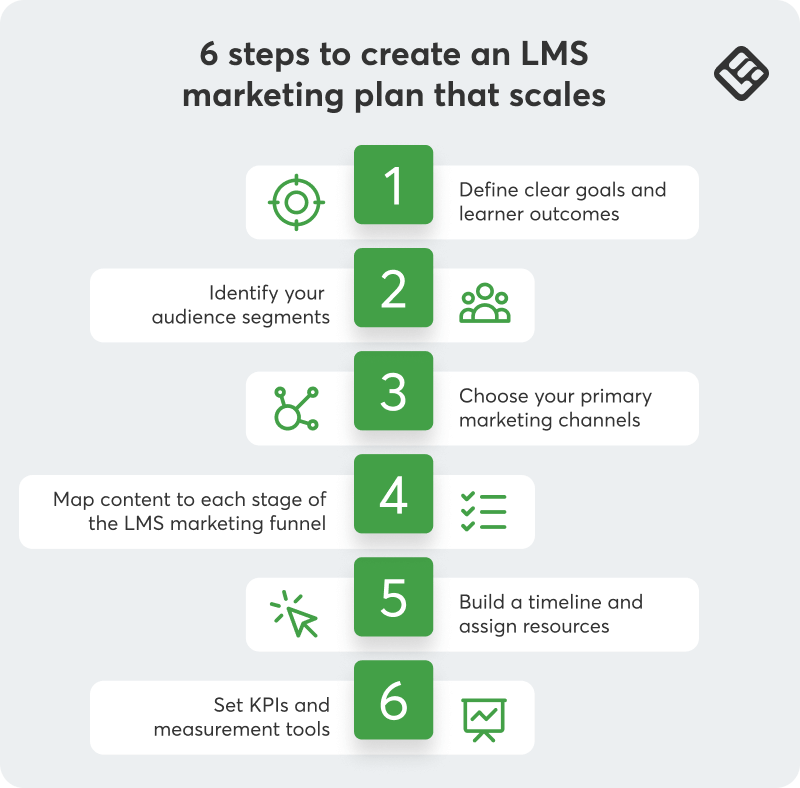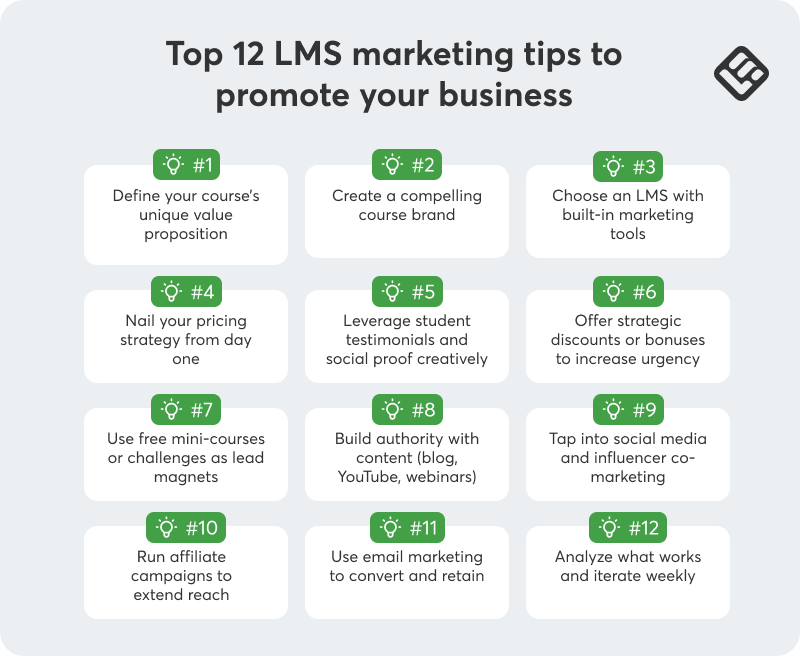Table of Contents
Serious about building momentum for your business this year? Your LMS (Learning Management System). With smart tactics, it can help you grow your revenue and keep learners coming back.
And with the elearning market expected to hit $1 trillion by 2032 [1], more creators and businesses are entering the space than ever. That means more competition for attention and enrollment. So, if you want your course to stand out, a strong marketing plan is where it’s at.
Here’s how to build an unshakable marketing plan and 12 marketing tips for your LMS worth trying in 2025.
How to create an LMS marketing plan that scales
Winging it with your marketing only works for so long. A focused LMS marketing plan can help you set priorities like which content to create and how to convert more site visitors into paying students. As part of your plan, it’s essential to define clear marketing goals to guide your efforts and measure success.

Start by picking a few clear outcomes. These could be to grow your email list, sell more courses, or increase course completions. Then, break those down into monthly targets.
For example, if you want 100 new students this quarter, how many leads do you need each week? How will you attract them? What will convince them to sign up? Use market research to inform your approach and better understand your target audience’s needs and preferences.
The next few steps will help you set those goals and build a plan that can grow with you as your business grows.
Define clear goals and learner outcomes
When was the last time you paid for a course just because it looked neat? Probably never. You likely paid for it because you could see how it would help you get the results you were after. So, before you write a single sales email, be clear on what your learners should be able to do after finishing your course.
Addressing your target audience’s pain points and introducing relevant learning concepts can help make sure your course meets their real needs and challenges. And be specific. Not just “learn Python,” but “build and deploy a basic web app.” Not just “become a better manager,” but “run more productive team meetings using proven templates.”
💡Need help writing these? Here’s a walkthrough on setting measurable learning objectives.
Document two or three learner outcomes and build your course page and ad copy around them. Displaying your outcomes to potential students will help you filter for qualified leads that are more likely to lead to repeat enrollments and satisfied learners.
Identify your audience segments
Take the time to build simple buyer personas. Ask yourself:
Understanding your target market and tailoring your messaging will help you attract potential clients who are most likely to benefit from your course.
Even just two clear audience types (like “new freelance graphic designers” or “agency owners upskilling their team”) can help you speak directly to their needs and craft offers that match their goals. It also makes it easier to choose proof points, like case studies or testimonials, that feel relevant to them.
Choose your primary marketing channels
Your course doesn’t need to be on every platform, but it does need to be where your audience already looks for help.
Here’s a quick breakdown of common marketing channels.
Google search: Best if your target audience is actively searching for what you teach. Requires time upfront to rank.
Instagram/TikTok: Good for visual or lifestyle-based topics. Short-form video works great here.
YouTube: Best for how-to, explainer, or tutorial-style content, and can work well with lead magnets.
LinkedIn: Ideal for B2B or professional certification-style courses.
Email: Still the best channel for conversions. Focus here once your email list starts growing.
The great thing about well-designed content is that it can be created once and then used across multiple marketing channels. Build, then repurpose. A long YouTube video could become five short social clips and a blog post. An email sequence can be supplemented with short, digestible TikTok bites.
And don’t forget to optimize your web pages for different stages of the buyer’s journey. This can help guide from awareness to decision. Use web banners and pop-ups on your site or LMS to visually promote learning content and reinforce your marketing messages.
Map content to each stage of the LMS marketing funnel
Not everyone is ready to buy the first time they visit your site. That’s normal. What matters is whether you have content that matches where they are in the buying journey.
💡Need help visualizing specific content ideas? Check out our list of 30 marketing ideas to promote online courses.
Use these ideas in one of the three areas of the content funnel: top, middle, and bottom. Here’s what that can look like.
Awareness phase (top of funnel): Blog posts that rank in search, short YouTube tutorials, or free downloads. The goal here is to collect email list signups and educate prospects who are just starting to recognize their problems.
Consideration phase (middle): Case studies, pricing breakdowns, webinars, or trial access. Offer free premium content, such as ebooks or reports, to help people compare options and nurture trust as they seek solutions.
Decision phase (bottom): Clear CTAs, social proof, urgency (bonuses, deadlines), and money-back guarantees.
If your funnel is missing content in one of these layers, fix that before you launch your next campaign. A comprehensive content marketing strategy guides prospects through each phase of the buyer’s journey.
💡For a full walk-through to help you do that, see our guide on sales funnels for online courses.
Build a timeline and assign resources
A Notion board, a paper planner, a Gantt chart—it doesn’t really matter what you use to plan your LMS marketing, but make sure you have a calendar and a clear timeline.
Decide what’s going out each week: blog post, email, video, social post. Then decide who’s doing it. If you’re the entire marketing team, pace yourself. Two strong content pieces a month will outperform a messy scramble every week.
Not sure what to post? Start by repurposing the course content you already have. Pick something that performs well and turn it into a blog series or lead magnet like a downloadable ebook. Keep track of how each piece performs and adjust.
Set KPIs and measurement tools
This is where most creators fall short: launching without tracking. Don’t be one of them.
Choose two or three KPIs tied to the current goal of your LMS marketing plan. If you’re trying to grow your email list, track opt-ins per source. If it’s sales, track conversion rate by channel (email, social, search).
Basic tools are fine. Your LMS platform probably has built-in reports, and Google Analytics or email platform dashboards can do the rest.
Look at results weekly, not just after a launch. Use the data to gain valuable insights into learner behavior and campaign effectiveness. Small tweaks like a new subject line or refined CTA can bump performance without extra content work.
Choosing the right LMS marketing strategy for your course model
Different course formats attract different types of learners, and they each come with their own buying behavior. A short course priced at $29 isn’t sold the same way as a $1,000 cohort program or a subscription-based membership.
To market your course effectively, your LMS marketing strategy needs to reflect how learners discover and commit to your specific format. Analyzing LMS companies and their key LMS marketing strategies can help you understand market trends and inform your own approach.
Here’s a breakdown of common course models and the types of marketing that tend to work best for each one.
To stand out, clearly identify your course’s unique selling points so you can differentiate it from competitors in the LMS space.
If you’re running more than one format, build separate funnels for each rather than cramming everything into a single landing page.
12 practical marketing tips: LMS-driven course businesses
Once your LMS marketing plan is in place, the next step is execution.
The tips below are practical actions you can take to attract more qualified leads. And with 74% of marketers saying that content marketing helps generate demand, this is a key area to focus on to drive interest.

Use these marketing tips to sharpen your LMS marketing strategy and reach more of the right learners.
Tip #1: Define your course’s unique value proposition
Before you start promoting anything, get clear on what makes your course worth someone’s time and money. What specific problem does it solve? Who is it built for? And what outcome can someone reasonably expect after completing it?
The sharper your answer, the easier it is to bring in qualified leads. For example, instead of “Learn video editing,” a stronger value prop would be “Learn how to edit professional-quality videos with DaVinci Resolve in under 30 days—even if you’ve never opened the software.”
Tip #2: Create a compelling course brand
Your brand sets the tone for the learning experience. It should reflect the pace and depth of your content as well as the type of learner you’re aiming to attract.
Everything from your page layout to the words you use in your emails contributes to your brand impression. Shaping a strong brand image through consistent messaging and visuals helps build trust and sets your course apart from competitors.
When it’s cohesive and intentional, it builds familiarity and trust, which makes your course feel more credible to learners at first glance. Successful brands use cohesive branding strategies to engage their audience, and you can apply similar techniques to engage learners and establish authority in your niche.
Tip #3: Choose an LMS with built-in marketing tools
Your training platform should help you deliver lessons, yes, but a modern LMS should do much more than just that. Choosing an LMS company with baked-in tools means less time setting up integrations and more time running real campaigns.
LearnWorlds’ marketing automations help you build funnels and send follow-ups to re-engage past students without needing outside software.
You can also take advantage of LearnWorlds’ new marketing integrations with CRMs, analytics tools, and ad platforms so you can track every step from click to conversion.
Tip #4: Nail your pricing strategy from day one
Okay, you probably won’t get it right on day one, but it’s important to remember that the pricing strategy you choose has a huge impact on who shows up and how seriously they take your offer. Research the going rates in your space, but also consider your course format, outcomes, and target audience.
You might want to consider offering payment plans for higher-ticket courses or bundles for lower-cost courses. If you’re unsure where to start, test different structures—like one-time payments versus split payments or early-bird discounts versus bonuses—and track signups and conversions.
Don’t sell yourself short by underpricing either. Know the value of your courses. Strong outcomes and clear messaging can support higher prices than you might expect, especially when your value is easy to see before checkout.
💡Read more: Understanding revenue streams and marketing tools to drive your success
Tip #5: Use student testimonials and social proof creatively
Potential students want to see that others like them have gotten results. And the way you present your testimonials can prop up your marketing copy and give it more credibility.
Here are some traditional ways to use social proof:
And here’s how to help that social proof creatively stand out to potential students:
💡Want more examples? Check out how social proof can be used on different course landing page types
Tip #6: Offer strategic discounts or bonuses to increase urgency
Discounts increase conversions best when they feel timely and relevant. Tie them to something real, like a course launch or seasonal promotion. Try to avoid generic countdown timers, as they don’t create a real sense of urgency, and potential learners might not take them seriously.
Bonuses can also be effective, especially when they add clear value. These could be something like a private Q&A session or a downloadable resource kit bundled with the course. These work particularly well for first-time buyers who might be looking for a reason to choose your course now instead of later.
Tip #7: Use free mini-courses or challenges as lead magnets
If your main course is $200 or more, a small, useful freebie can help people warm up to you. Something like a free mini-course or email challenge can show your instructional style and build trust. Free mini-courses also allow you to deliver bite-sized content and implement microlearning modules, which can boost engagement.
Keep the format lightweight and promote it through your chosen social channels and website to steadily grow your email list with leads who are already interested in your topic. These strategies help maintain user interest over time.
Tip #8: Build authority with content (blog, YouTube, webinars)
High-quality content should be focused on increasing traffic and on building trust. Things like blog posts can show up in search engines and help build your authority on a subject, and webinars can let people experience your course before they buy. Creating valuable content that addresses learners’ needs at each stage of their journey helps you establish authority and build trust with your audience.
This also gives your marketing team (even if that’s just you) assets they can share across channels. You don’t need a huge output either, just regular sharing of helpful, relevant content.
Tip #9: Tap into social media and influencer co-marketing
As a broader part of your social media strategy, find people who already speak to your audience. That might be a niche podcast host or a micro-influencer with an engaged following who covers topics like yours. Collaborating with these partners is also a great way of engaging users, as it encourages interaction and participation from both audiences.
Start by proposing a joint live stream or a content swap. These small collaborations can expand your reach fast, especially if your buyer personas match closely. To maximize results, create compelling content tailored for social media that encourages sharing and interaction.
Tip #10: Run affiliate campaigns to extend reach
Affiliate programs let others promote your course in exchange for a cut of each sale. This works well if you already have students or industry peers who believe in your content. Loyal customers can become your best advocates in affiliate campaigns, helping to build trust and expand your reach.
Use a simple platform that provides trackable links and lets you see who’s bringing in traffic. Make it easy: offer copy/paste email templates and promotional materials with fast payouts. A few good affiliates can make a measurable difference in your marketing efforts.
Tip #11: Use email marketing to convert and retain
Email is still one of the most reliable ways to convert leads and keep students engaged. It gives you a direct path from interest to purchase without relying on algorithms or ad spend. It’s most effective when paired with one of the best email marketing tools and a good email sequence setup.
Here are a few sequences to start with:
💡Want more examples? See how to sell online courses using email marketing.
Tip #12: Analyze what works and iterate weekly
If you’re not reviewing performance regularly, it’s hard to know what’s actually helping your course grow. Set a weekly time to review what’s working and where people seem to lose interest. And monitor that user interest to identify which content and strategies are most effective at engaging learners.
When you spot something underperforming, you don’t need to overhaul everything. Instead, make one specific change so you can track that change’s performance. What works in one part of your LMS marketing might not work in another, so try a few variations and see what gets the best response.
Improve your LMS marketing tactics with LearnWorlds’ features
Building and marketing a great course is easier when your tools work with you. LearnWorlds features are made for course creators who want to grow, not just deliver content. From built-in landing pages and email automations to detailed analytics and customizable funnels, you get more control over how people discover and engage with your courses.
You can also connect LearnWorlds to your favorite tools and track performance across every stage of your funnel—all from one dashboard.
Start a free trial today and see how LearnWorlds can help you turn traffic into sign-ups.
Sources
[1] Elearning market size & share industry report 2023 – 2032

Ciera Lamb
Ciera is a freelance content writer and editor connecting companies with their ideal audiences through blog articles and other online content. She approaches her writing with curiosity and research and enjoys the ever-present learning that comes with being a content writer. She is also an avid scuba diver, an aspiring Dutch speaker, and lover of all things nature.




